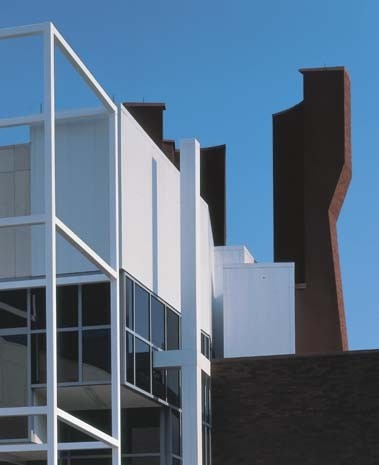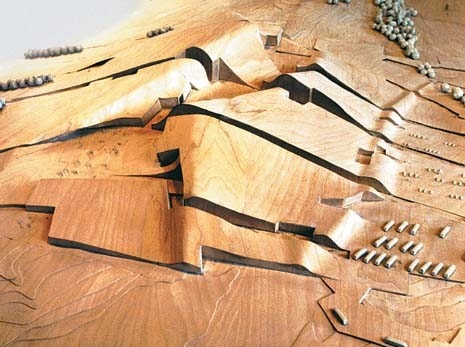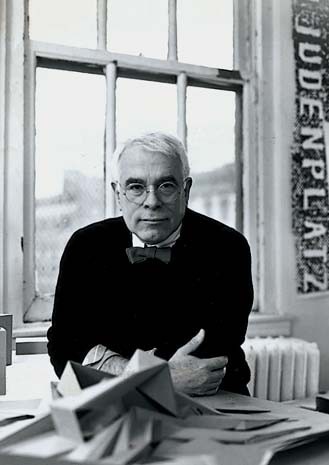Peter Eisenman celebrated his 70th birthday this summer with a handwritten note of congratulations from the German chancellor and a card from King Carlos of Spain. How do I know? Because that is what he told a press conference gathered in Venice to unveil his project for Santiago de Compostela’s epic-scale cultural centre – an event, incidentally, that attracted the presence of three TV crews and the Galician minister for culture. Eisenman is clearly big in Germany, having worked on the monumental holocaust memorial in Berlin that takes the shape of a field of concrete monoliths in a mute encampment near the Brandenburg Gate. And with Peter Kulka he is planning the infrastructure for the country’s bid for the next available Olympics. He is even bigger in Spain; the Compostela project has involved excavating an entire mountain to make way for a collection of opera houses, museums and libraries on the scale of Lincoln Center. It would be ambitious anywhere, but in a city of just 250,000, it looks dangerously like hubris.
But Eisenman didn’t tell us about his presidential letter to convey that the Germans think he is important. It was a reflection more of vulnerability than self-confidence. The words came tumbling out when someone asked him a question about what he was building in America. From his momentary silence it was pretty clear George W. Bush has not only failed to acknowledge Eisenman’s big day, but that he has never even heard of him.
All architects, from Frank Gehry to David Chipperfield and, scarcely believably, Norman Foster, get irked about failing to get what they see as their due on their own turf. But even though Eisenman is now working on more and bigger projects than at any other time in his career, one still senses a touching self-doubt to him. Perhaps it stems from a nagging concern that he has no cushion of corporate fat to keep the hard times at bay in his resolutely un-chic Manhattan loft studio: not a comfortable position for a figure of his prominence. And there have certainly been hard times, not to say a few hard words, since he came back to America from his days as a post-graduate student in Cambridge in 1963.
There was the business of the Institute of Architectural and Urban Studies, which he helped to set up in 1967, and its sudden closure when it ran out of cash, along with the folding of Oppositions, the magazine he edited for nearly ten years.
And even the formidably clever early houses with which he made his reputation in the 1960s, qualifying him for charter membership in the New York Five, left a background of more than usually unhappy fallout from a procession of clients initially dazzled by Eisenman’s brilliance and then dismayed at his refusal, as he once put it, ‘to deal with their marital privacy issues’.
For reasons that are, at this distance, hard to fathom, the New York Five, the so-called whites that Ken Frampton put on show at the Museum of Modern Art, seemed as if they were going to be the biggest thing since abstract expressionism, a mix of new-world daring and old-world intellectual credibility. As individuals they were certainly the dominant figures of the next two decades, at least untill Frank Gehry came along. But it was never really a group.
It’s hard now to imagine that there could ever have been any shared ground between Michael Graves and Richard Meier or Charles Gwathmey and John Hejduk. Or between Peter Eisenman and any of them, except the now-deceased Hejduk. But at the time they were presented as the architectural super-group. Eisenman, in particular – something of a dandy in his day with his trademark bowtie and braces – was as ubiquitous in the photographs of the period as Andy Warhol. Eisenman was seen as the essential link between American and European sensibilities.
The New York Five still cast a long shadow. Three of the four survivors have reformed this autumn for the competition for the site of the twin towers. Like any other self-respecting 60s survivors they needed a new drummer, of course. To that end Steven Holl is standing in for Michael Graves, the victim of a bad case of postmodernism.
That Steven Holl would line up alongside Eisenman is a demonstration of the fact that Eisenman still matters. In fact, he probably matters more than he has ever done. He has dedicated his entire career to the proposition that architecture is as much an intellectual pursuit as it is a material one. But at his time of life he is being called on to rise to a fresh challenge, that of making buildings that are both cerebral and physical. George Bush may still not know his name, though that might change if Eisenman comes up with anything as dismaying for the Ground Zero competition as the scheme he drew up for the New York Times, showing a wall of skyscrapers designed to look as if they were at the point of implosion. But Eisenman cannot complain that he is not getting the breaks.




